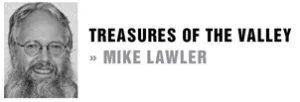In my self-appointed role of local historian I’ve often said that although the Crescenta Valley has a relatively short written history, barely over 100 years, we make up for that with a dynamic history that reads like a supermarket tabloid. Its pages are filled with stories of UFOs, Nazis, grisly murders, sex scandals, racial prejudice, kidnappings, insanity, and of course, Hollywood stars.
Add to that list the Crescenta Valley’s own prison for so-called “enemy aliens” during WWII. It was an armed camp, where interrogations were conducted, while soldiers patrolled the 12-foot tall barbed-wire fenced perimeters.
This next chapter of the amazing history of the site that is now the Verdugo Hills Golf Course begins with the Dec. 7, 1941 Japanese attack on Pearl Harbor. Although it caught American civilians, and the U.S. Navy, off guard elements of U.S. intelligence in California were very ready, and swung into action immediately. The FBI began rounding up anyone who was even remotely suspected of having a tendency to disloyalty or who had any connections, no matter how remote, to foreign powers that we would be soon be in conflict with. The Immigration and Naturalization Service, essentially the Border Patrol, did their part in this effort by establishing holding areas for all the non-U.S. citizens that were bound to get caught in the FBI’s nets.
On Dec. 8, the day after Pearl Harbor, the Department of Justice commandeered the former CCC camp known as La Tuna Camp, and began stringing barbed-wire, setting up sentry stations and floodlights. They renamed the site the “Tuna Canyon Detention Station.” Only a week later, the camp received its first prisoners, mostly Japanese from fishing communities in San Pedro and the South Bay, and by Christmas the camp held 95 men.
Tuna Canyon Detention Station, known informally as “Tuna Camp,” differed from the internment camps such as Manzanar in that it was specifically for non-citizens, whereas the internment camps held all people of Japanese descent, even U.S. citizens. Because of restrictive immigration policies, many Asians born outside of the U.S. were not eligible for citizenship, even if they had lived here their entire lives.
If those individuals maintained any connection at all to their culture or their native country they were considered suspect. Many rounded up were Japanese language instructors, photographers, martial arts practioners or even radio enthusiasts. Any non-citizen in the Japanese-American community that showed leadership abilities, such as heads of chambers of commerce or religious leaders, were arrested. Anyone who could form or participate in a “fifth column” was taken out of circulation.
These policies seem harsh by today’s standards, but when one looks back on the newspapers from the months just after Pearl Harbor, one realizes that the West Coast was in full panic mode. News articles carried the headlines “Water Hoarded In Japanese Homes” and “Pupils Taught Hirohito Divine,” and the articles carried tales of Japanese fishermen being caught signaling Japanese submarines, or secret stashes of binoculars, cameras and short-wave radios found in Japanese-American homes. Californians, it seems, expected attack by sea from Japan, and they were suspicious that Japanese-Americans would rise up to help the invasion.
And so Tuna Camp became a first stop for those of Japanese, German or Italian descent that had no, or couldn’t prove, U.S. citizenship. They were processed, sorted, and interrogated at Tuna Camp, and then sent on to larger federal prisons inland, to internment camps, or occasionally, in the case of a few lucky Europeans, released. A report issued from Tuna Camp in 1942 reported that from Dec. 16, 1941 to May 25, 1942 of 1490 Japanese males processed through the camp, 1378 were transferred to Federal prisons in Ft. Missoula, Ft. Lincoln and Santa Fe, 36 were released, presumably to join their families in internment camps, and 76 were still in custody. Other reports record German and Italian citizens being picked up on curfew violations (p.m.), interrogated, and either being sent to prison, or released.
I’ll follow in the next few weeks with some amazing stories of the drama, tragedy and triumph that took place at Tuna Camp.
Mike Lawler is the president of the Historical Society of the
Crescenta Valley. Reach him at lawlerdad@yahoo.com.

